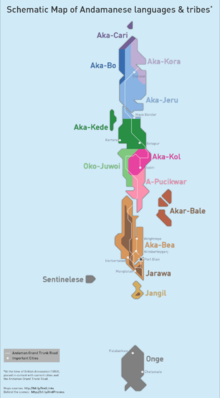The Kari, Cari, or Chariar were one of the ten indigenous Great Andamanese peoples, originally living on the northernmost part of North Andaman Island and on Landfall Island in the Indian Ocean.

The Cari spoke a distinctive language, Aka-Cari, closely related to the other Great Andamanese languages. They were exclusively shore-dwellers (aryoto).[1]
History edit
The Cari population at the time of first European contacts (in the 1790s) has been estimated at 100 individuals, out of perhaps 3500 Great Andamanese.[2] Like other Andamanese peoples, the Cari were decimated during colonial and post-colonial times, by diseases, alcohol, colonial warfare and loss of territory. The population was down to 39 individuals in the 1901 census, falling to 36 in 1911, 17 in 1921, and 9 in 1931.[3]
In 1949 any remaining Cari were relocated, together with all other surviving Great Andamanese, to a reservation on Bluff island; and then again in 1969 to a reservation on Strait Island.[4]
By 1994, the population was reduced to only two women, aged 57 and 59, and therefore was on its way to extinction.[3] They are a designated Scheduled Tribe.[5]
References edit
- ^ George Weber (~2009), The Tribes Archived May 7, 2013, at the Wayback Machine. Chapter 8 in The Andamanese Archived July 24, 2013, at the Wayback Machine. Accessed on 2012-07-12.
- ^ George Weber (~2009), Numbers Archived May 31, 2012, at the Wayback Machine. Chapter 7 in The Andamanese Archived July 24, 2013, at the Wayback Machine. Accessed on 2012-07-12.
- ^ a b A. N. Sharma (2003), Tribal Development in the Andaman Islands, page 62. Sarup & Sons, New Delhi.
- ^ Rann Singh Mann (2005), Andaman and Nicobar Tribes Restudied: Encounters and Concerns, page 149. Mittal Publications. ISBN 81-8324-010-0
- ^ "List of notified Scheduled Tribes" (PDF). Census India. p. 27. Archived from the original (PDF) on 7 November 2013. Retrieved 15 December 2013.